Contract Law | Business Law Assignment
VerifiedAdded on 2022/09/12
|10
|2192
|10
AI Summary
Contribute Materials
Your contribution can guide someone’s learning journey. Share your
documents today.
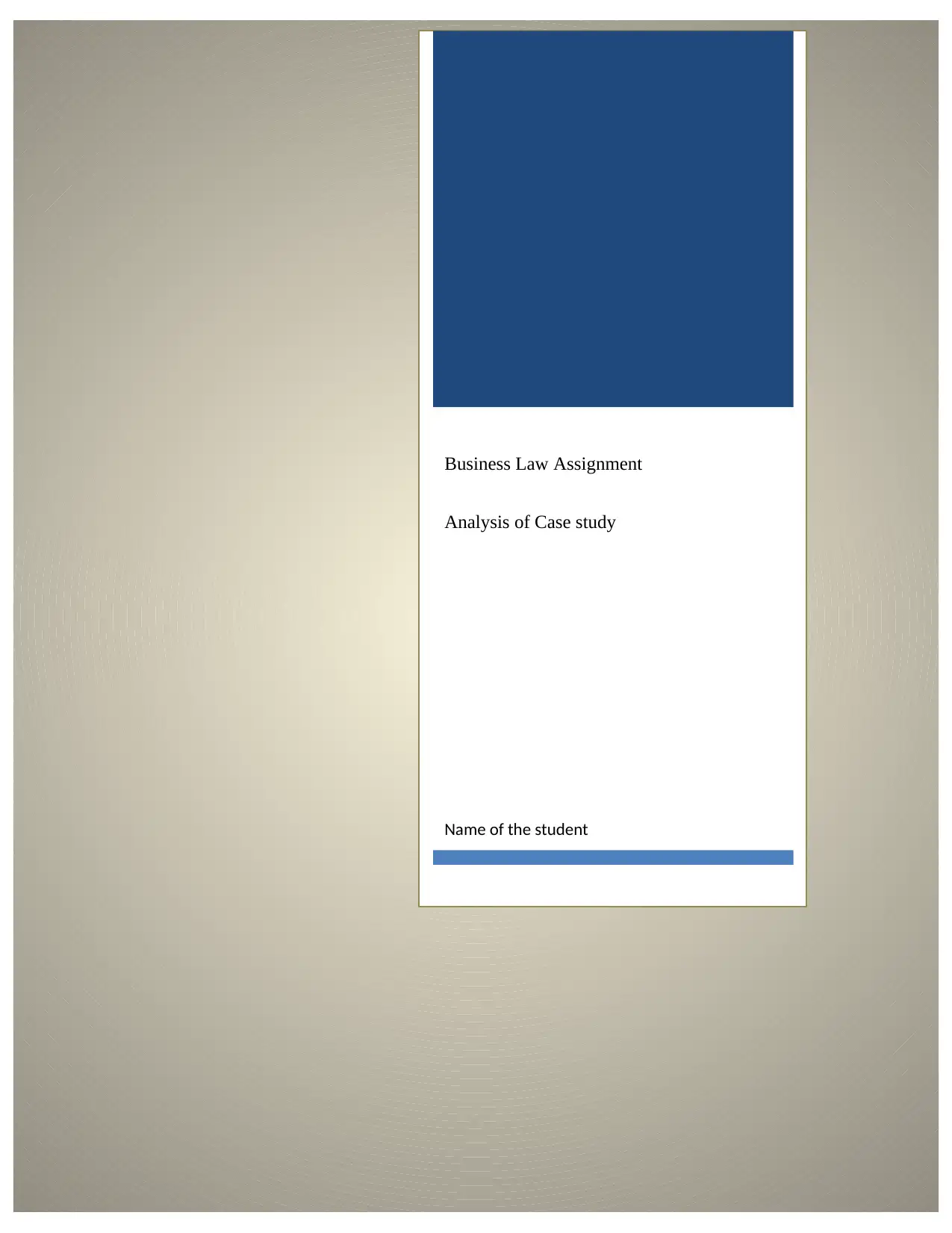
Business Law Assignment
Analysis of Case study
Name of the student
Analysis of Case study
Name of the student
Secure Best Marks with AI Grader
Need help grading? Try our AI Grader for instant feedback on your assignments.
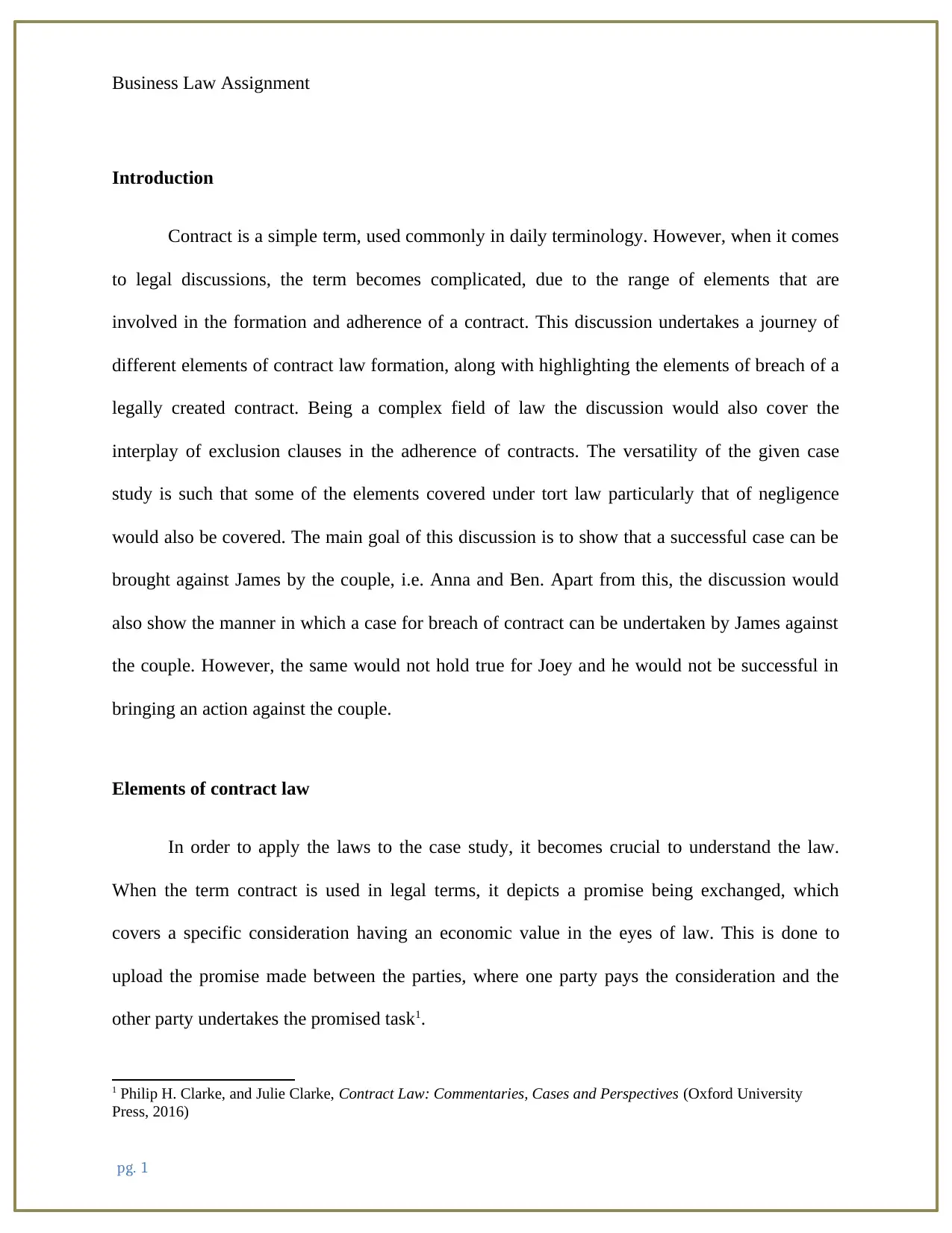
Business Law Assignment
Introduction
Contract is a simple term, used commonly in daily terminology. However, when it comes
to legal discussions, the term becomes complicated, due to the range of elements that are
involved in the formation and adherence of a contract. This discussion undertakes a journey of
different elements of contract law formation, along with highlighting the elements of breach of a
legally created contract. Being a complex field of law the discussion would also cover the
interplay of exclusion clauses in the adherence of contracts. The versatility of the given case
study is such that some of the elements covered under tort law particularly that of negligence
would also be covered. The main goal of this discussion is to show that a successful case can be
brought against James by the couple, i.e. Anna and Ben. Apart from this, the discussion would
also show the manner in which a case for breach of contract can be undertaken by James against
the couple. However, the same would not hold true for Joey and he would not be successful in
bringing an action against the couple.
Elements of contract law
In order to apply the laws to the case study, it becomes crucial to understand the law.
When the term contract is used in legal terms, it depicts a promise being exchanged, which
covers a specific consideration having an economic value in the eyes of law. This is done to
upload the promise made between the parties, where one party pays the consideration and the
other party undertakes the promised task1.
1 Philip H. Clarke, and Julie Clarke, Contract Law: Commentaries, Cases and Perspectives (Oxford University
Press, 2016)
pg. 1
Introduction
Contract is a simple term, used commonly in daily terminology. However, when it comes
to legal discussions, the term becomes complicated, due to the range of elements that are
involved in the formation and adherence of a contract. This discussion undertakes a journey of
different elements of contract law formation, along with highlighting the elements of breach of a
legally created contract. Being a complex field of law the discussion would also cover the
interplay of exclusion clauses in the adherence of contracts. The versatility of the given case
study is such that some of the elements covered under tort law particularly that of negligence
would also be covered. The main goal of this discussion is to show that a successful case can be
brought against James by the couple, i.e. Anna and Ben. Apart from this, the discussion would
also show the manner in which a case for breach of contract can be undertaken by James against
the couple. However, the same would not hold true for Joey and he would not be successful in
bringing an action against the couple.
Elements of contract law
In order to apply the laws to the case study, it becomes crucial to understand the law.
When the term contract is used in legal terms, it depicts a promise being exchanged, which
covers a specific consideration having an economic value in the eyes of law. This is done to
upload the promise made between the parties, where one party pays the consideration and the
other party undertakes the promised task1.
1 Philip H. Clarke, and Julie Clarke, Contract Law: Commentaries, Cases and Perspectives (Oxford University
Press, 2016)
pg. 1
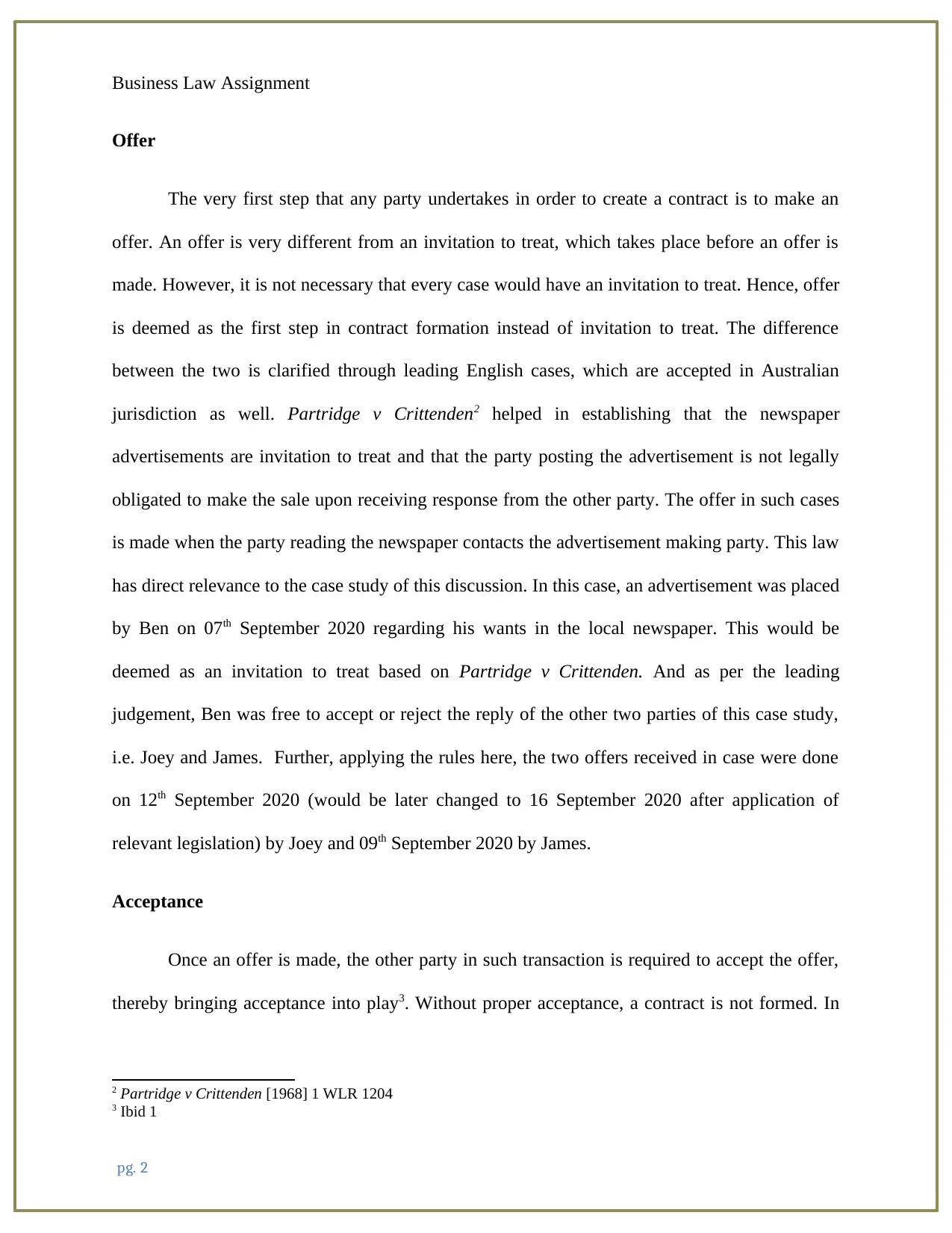
Business Law Assignment
Offer
The very first step that any party undertakes in order to create a contract is to make an
offer. An offer is very different from an invitation to treat, which takes place before an offer is
made. However, it is not necessary that every case would have an invitation to treat. Hence, offer
is deemed as the first step in contract formation instead of invitation to treat. The difference
between the two is clarified through leading English cases, which are accepted in Australian
jurisdiction as well. Partridge v Crittenden2 helped in establishing that the newspaper
advertisements are invitation to treat and that the party posting the advertisement is not legally
obligated to make the sale upon receiving response from the other party. The offer in such cases
is made when the party reading the newspaper contacts the advertisement making party. This law
has direct relevance to the case study of this discussion. In this case, an advertisement was placed
by Ben on 07th September 2020 regarding his wants in the local newspaper. This would be
deemed as an invitation to treat based on Partridge v Crittenden. And as per the leading
judgement, Ben was free to accept or reject the reply of the other two parties of this case study,
i.e. Joey and James. Further, applying the rules here, the two offers received in case were done
on 12th September 2020 (would be later changed to 16 September 2020 after application of
relevant legislation) by Joey and 09th September 2020 by James.
Acceptance
Once an offer is made, the other party in such transaction is required to accept the offer,
thereby bringing acceptance into play3. Without proper acceptance, a contract is not formed. In
2 Partridge v Crittenden [1968] 1 WLR 1204
3 Ibid 1
pg. 2
Offer
The very first step that any party undertakes in order to create a contract is to make an
offer. An offer is very different from an invitation to treat, which takes place before an offer is
made. However, it is not necessary that every case would have an invitation to treat. Hence, offer
is deemed as the first step in contract formation instead of invitation to treat. The difference
between the two is clarified through leading English cases, which are accepted in Australian
jurisdiction as well. Partridge v Crittenden2 helped in establishing that the newspaper
advertisements are invitation to treat and that the party posting the advertisement is not legally
obligated to make the sale upon receiving response from the other party. The offer in such cases
is made when the party reading the newspaper contacts the advertisement making party. This law
has direct relevance to the case study of this discussion. In this case, an advertisement was placed
by Ben on 07th September 2020 regarding his wants in the local newspaper. This would be
deemed as an invitation to treat based on Partridge v Crittenden. And as per the leading
judgement, Ben was free to accept or reject the reply of the other two parties of this case study,
i.e. Joey and James. Further, applying the rules here, the two offers received in case were done
on 12th September 2020 (would be later changed to 16 September 2020 after application of
relevant legislation) by Joey and 09th September 2020 by James.
Acceptance
Once an offer is made, the other party in such transaction is required to accept the offer,
thereby bringing acceptance into play3. Without proper acceptance, a contract is not formed. In
2 Partridge v Crittenden [1968] 1 WLR 1204
3 Ibid 1
pg. 2
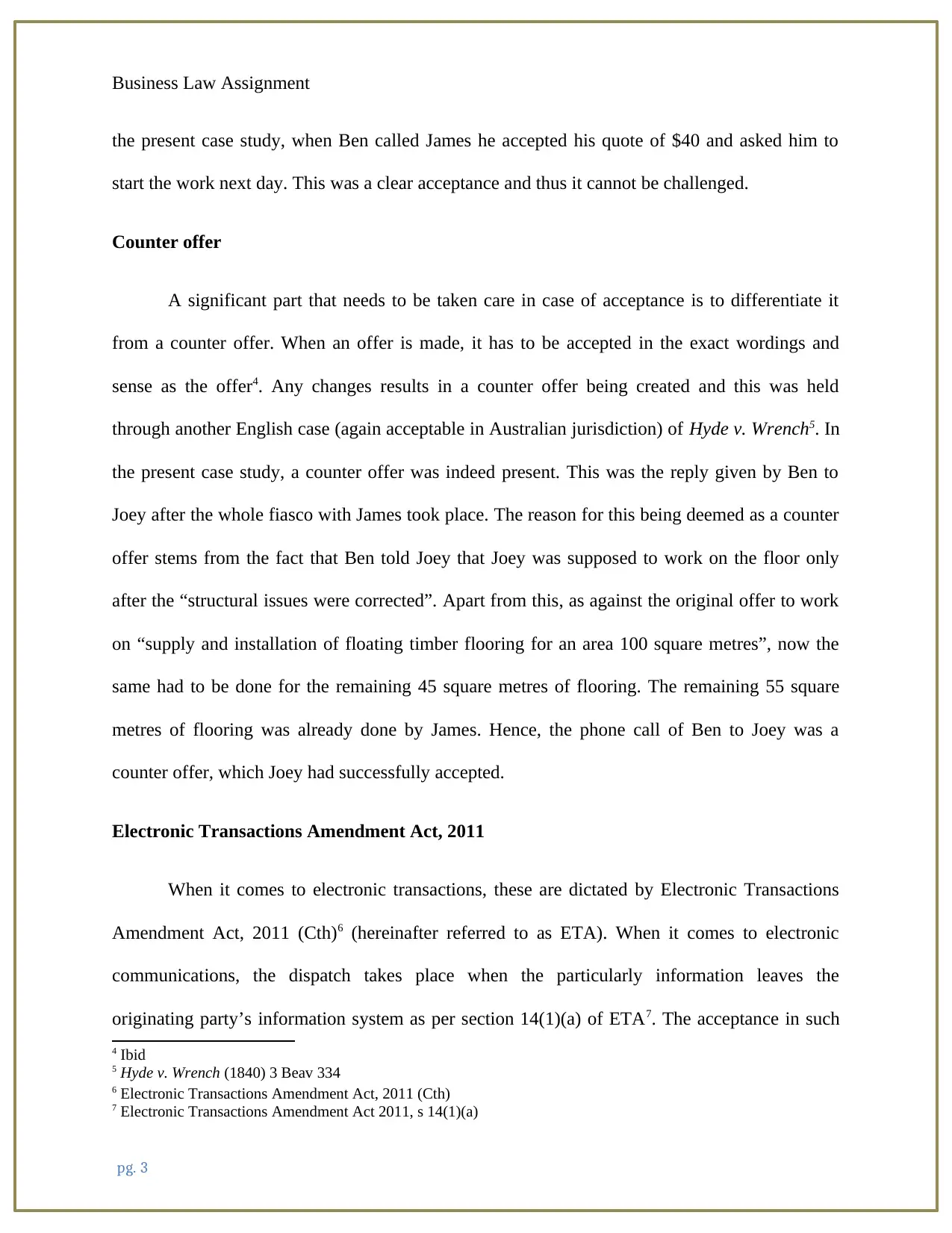
Business Law Assignment
the present case study, when Ben called James he accepted his quote of $40 and asked him to
start the work next day. This was a clear acceptance and thus it cannot be challenged.
Counter offer
A significant part that needs to be taken care in case of acceptance is to differentiate it
from a counter offer. When an offer is made, it has to be accepted in the exact wordings and
sense as the offer4. Any changes results in a counter offer being created and this was held
through another English case (again acceptable in Australian jurisdiction) of Hyde v. Wrench5. In
the present case study, a counter offer was indeed present. This was the reply given by Ben to
Joey after the whole fiasco with James took place. The reason for this being deemed as a counter
offer stems from the fact that Ben told Joey that Joey was supposed to work on the floor only
after the “structural issues were corrected”. Apart from this, as against the original offer to work
on “supply and installation of floating timber flooring for an area 100 square metres”, now the
same had to be done for the remaining 45 square metres of flooring. The remaining 55 square
metres of flooring was already done by James. Hence, the phone call of Ben to Joey was a
counter offer, which Joey had successfully accepted.
Electronic Transactions Amendment Act, 2011
When it comes to electronic transactions, these are dictated by Electronic Transactions
Amendment Act, 2011 (Cth)6 (hereinafter referred to as ETA). When it comes to electronic
communications, the dispatch takes place when the particularly information leaves the
originating party’s information system as per section 14(1)(a) of ETA7. The acceptance in such
4 Ibid
5 Hyde v. Wrench (1840) 3 Beav 334
6 Electronic Transactions Amendment Act, 2011 (Cth)
7 Electronic Transactions Amendment Act 2011, s 14(1)(a)
pg. 3
the present case study, when Ben called James he accepted his quote of $40 and asked him to
start the work next day. This was a clear acceptance and thus it cannot be challenged.
Counter offer
A significant part that needs to be taken care in case of acceptance is to differentiate it
from a counter offer. When an offer is made, it has to be accepted in the exact wordings and
sense as the offer4. Any changes results in a counter offer being created and this was held
through another English case (again acceptable in Australian jurisdiction) of Hyde v. Wrench5. In
the present case study, a counter offer was indeed present. This was the reply given by Ben to
Joey after the whole fiasco with James took place. The reason for this being deemed as a counter
offer stems from the fact that Ben told Joey that Joey was supposed to work on the floor only
after the “structural issues were corrected”. Apart from this, as against the original offer to work
on “supply and installation of floating timber flooring for an area 100 square metres”, now the
same had to be done for the remaining 45 square metres of flooring. The remaining 55 square
metres of flooring was already done by James. Hence, the phone call of Ben to Joey was a
counter offer, which Joey had successfully accepted.
Electronic Transactions Amendment Act, 2011
When it comes to electronic transactions, these are dictated by Electronic Transactions
Amendment Act, 2011 (Cth)6 (hereinafter referred to as ETA). When it comes to electronic
communications, the dispatch takes place when the particularly information leaves the
originating party’s information system as per section 14(1)(a) of ETA7. The acceptance in such
4 Ibid
5 Hyde v. Wrench (1840) 3 Beav 334
6 Electronic Transactions Amendment Act, 2011 (Cth)
7 Electronic Transactions Amendment Act 2011, s 14(1)(a)
pg. 3
Secure Best Marks with AI Grader
Need help grading? Try our AI Grader for instant feedback on your assignments.
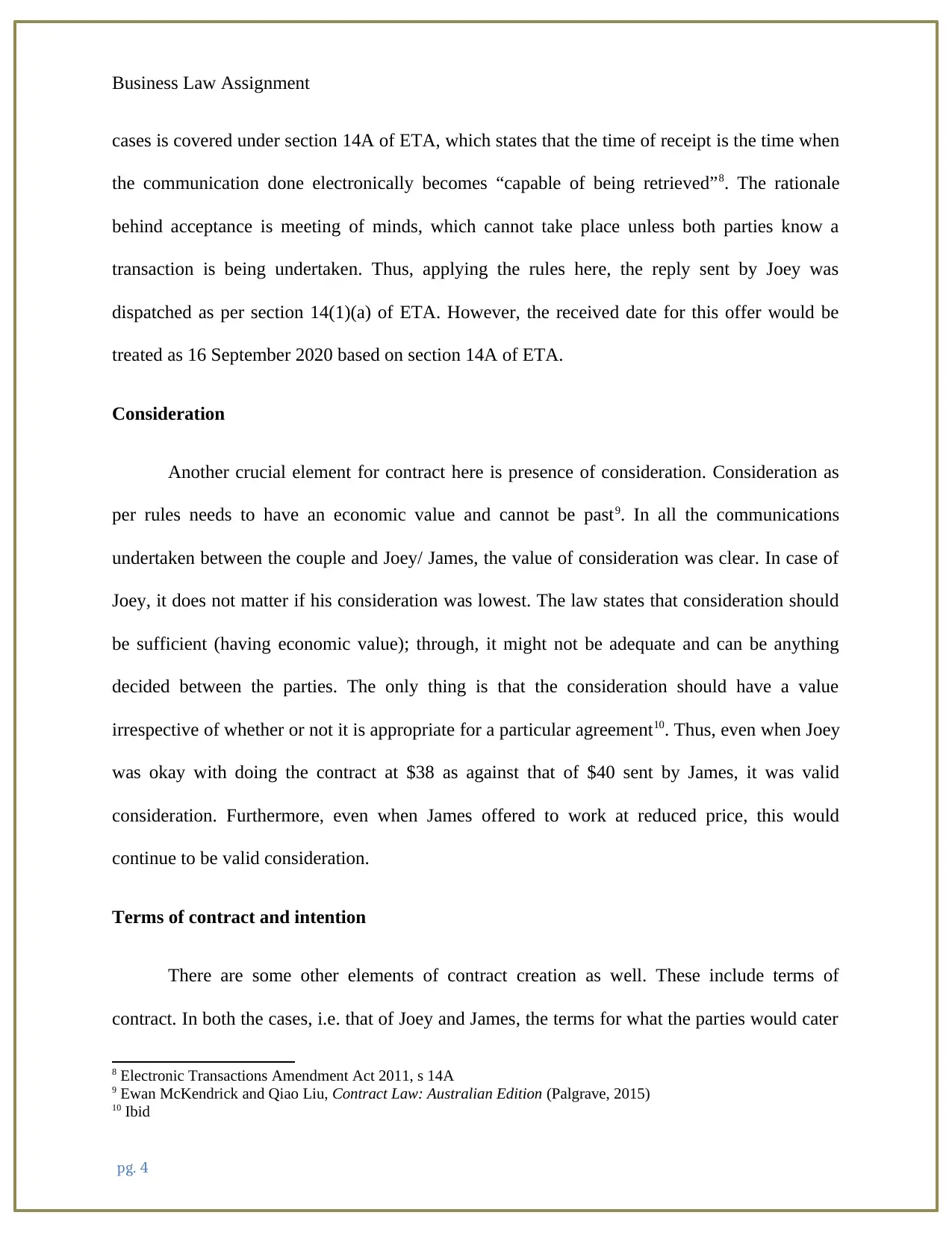
Business Law Assignment
cases is covered under section 14A of ETA, which states that the time of receipt is the time when
the communication done electronically becomes “capable of being retrieved”8. The rationale
behind acceptance is meeting of minds, which cannot take place unless both parties know a
transaction is being undertaken. Thus, applying the rules here, the reply sent by Joey was
dispatched as per section 14(1)(a) of ETA. However, the received date for this offer would be
treated as 16 September 2020 based on section 14A of ETA.
Consideration
Another crucial element for contract here is presence of consideration. Consideration as
per rules needs to have an economic value and cannot be past9. In all the communications
undertaken between the couple and Joey/ James, the value of consideration was clear. In case of
Joey, it does not matter if his consideration was lowest. The law states that consideration should
be sufficient (having economic value); through, it might not be adequate and can be anything
decided between the parties. The only thing is that the consideration should have a value
irrespective of whether or not it is appropriate for a particular agreement10. Thus, even when Joey
was okay with doing the contract at $38 as against that of $40 sent by James, it was valid
consideration. Furthermore, even when James offered to work at reduced price, this would
continue to be valid consideration.
Terms of contract and intention
There are some other elements of contract creation as well. These include terms of
contract. In both the cases, i.e. that of Joey and James, the terms for what the parties would cater
8 Electronic Transactions Amendment Act 2011, s 14A
9 Ewan McKendrick and Qiao Liu, Contract Law: Australian Edition (Palgrave, 2015)
10 Ibid
pg. 4
cases is covered under section 14A of ETA, which states that the time of receipt is the time when
the communication done electronically becomes “capable of being retrieved”8. The rationale
behind acceptance is meeting of minds, which cannot take place unless both parties know a
transaction is being undertaken. Thus, applying the rules here, the reply sent by Joey was
dispatched as per section 14(1)(a) of ETA. However, the received date for this offer would be
treated as 16 September 2020 based on section 14A of ETA.
Consideration
Another crucial element for contract here is presence of consideration. Consideration as
per rules needs to have an economic value and cannot be past9. In all the communications
undertaken between the couple and Joey/ James, the value of consideration was clear. In case of
Joey, it does not matter if his consideration was lowest. The law states that consideration should
be sufficient (having economic value); through, it might not be adequate and can be anything
decided between the parties. The only thing is that the consideration should have a value
irrespective of whether or not it is appropriate for a particular agreement10. Thus, even when Joey
was okay with doing the contract at $38 as against that of $40 sent by James, it was valid
consideration. Furthermore, even when James offered to work at reduced price, this would
continue to be valid consideration.
Terms of contract and intention
There are some other elements of contract creation as well. These include terms of
contract. In both the cases, i.e. that of Joey and James, the terms for what the parties would cater
8 Electronic Transactions Amendment Act 2011, s 14A
9 Ewan McKendrick and Qiao Liu, Contract Law: Australian Edition (Palgrave, 2015)
10 Ibid
pg. 4
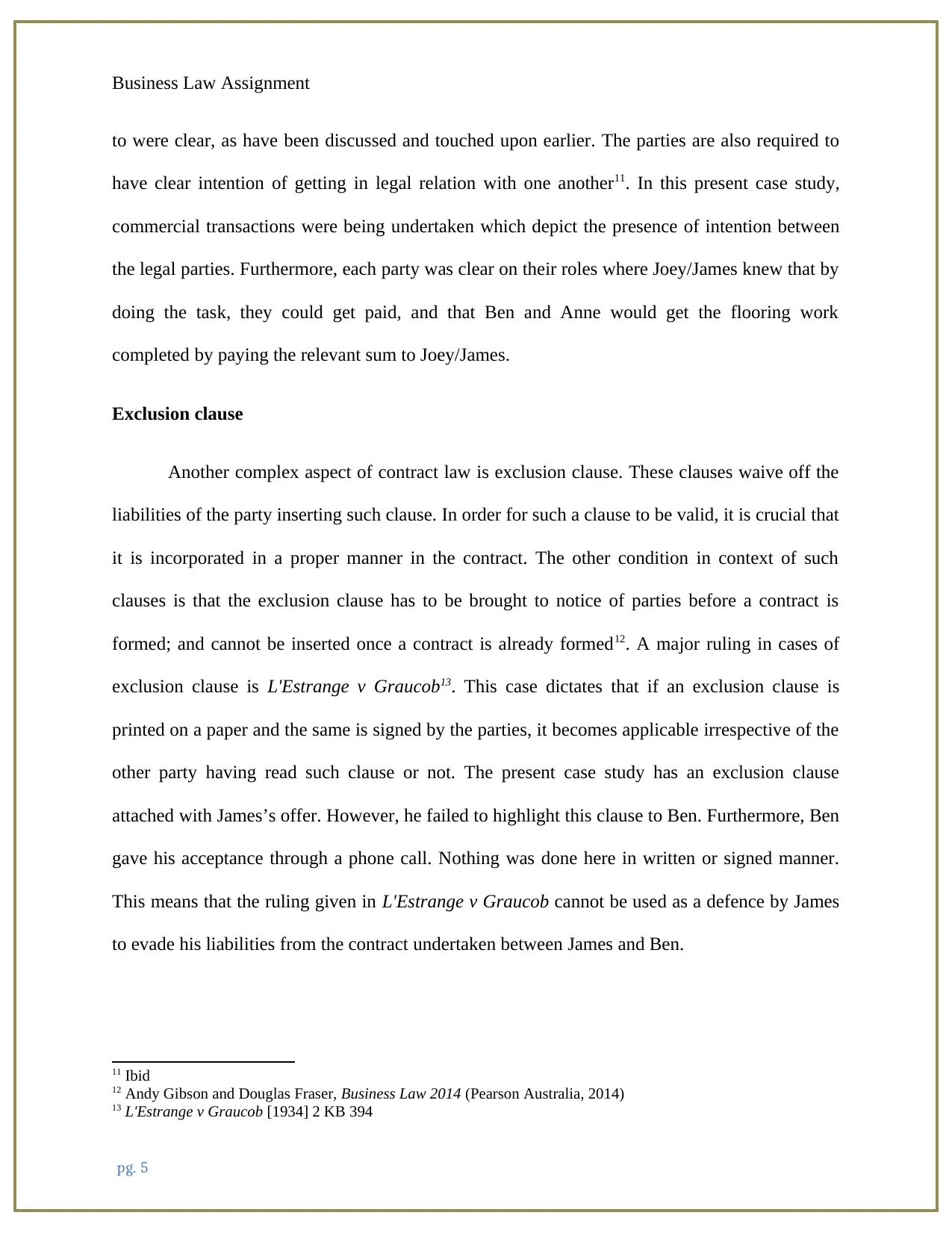
Business Law Assignment
to were clear, as have been discussed and touched upon earlier. The parties are also required to
have clear intention of getting in legal relation with one another11. In this present case study,
commercial transactions were being undertaken which depict the presence of intention between
the legal parties. Furthermore, each party was clear on their roles where Joey/James knew that by
doing the task, they could get paid, and that Ben and Anne would get the flooring work
completed by paying the relevant sum to Joey/James.
Exclusion clause
Another complex aspect of contract law is exclusion clause. These clauses waive off the
liabilities of the party inserting such clause. In order for such a clause to be valid, it is crucial that
it is incorporated in a proper manner in the contract. The other condition in context of such
clauses is that the exclusion clause has to be brought to notice of parties before a contract is
formed; and cannot be inserted once a contract is already formed12. A major ruling in cases of
exclusion clause is L'Estrange v Graucob13. This case dictates that if an exclusion clause is
printed on a paper and the same is signed by the parties, it becomes applicable irrespective of the
other party having read such clause or not. The present case study has an exclusion clause
attached with James’s offer. However, he failed to highlight this clause to Ben. Furthermore, Ben
gave his acceptance through a phone call. Nothing was done here in written or signed manner.
This means that the ruling given in L'Estrange v Graucob cannot be used as a defence by James
to evade his liabilities from the contract undertaken between James and Ben.
11 Ibid
12 Andy Gibson and Douglas Fraser, Business Law 2014 (Pearson Australia, 2014)
13 L'Estrange v Graucob [1934] 2 KB 394
pg. 5
to were clear, as have been discussed and touched upon earlier. The parties are also required to
have clear intention of getting in legal relation with one another11. In this present case study,
commercial transactions were being undertaken which depict the presence of intention between
the legal parties. Furthermore, each party was clear on their roles where Joey/James knew that by
doing the task, they could get paid, and that Ben and Anne would get the flooring work
completed by paying the relevant sum to Joey/James.
Exclusion clause
Another complex aspect of contract law is exclusion clause. These clauses waive off the
liabilities of the party inserting such clause. In order for such a clause to be valid, it is crucial that
it is incorporated in a proper manner in the contract. The other condition in context of such
clauses is that the exclusion clause has to be brought to notice of parties before a contract is
formed; and cannot be inserted once a contract is already formed12. A major ruling in cases of
exclusion clause is L'Estrange v Graucob13. This case dictates that if an exclusion clause is
printed on a paper and the same is signed by the parties, it becomes applicable irrespective of the
other party having read such clause or not. The present case study has an exclusion clause
attached with James’s offer. However, he failed to highlight this clause to Ben. Furthermore, Ben
gave his acceptance through a phone call. Nothing was done here in written or signed manner.
This means that the ruling given in L'Estrange v Graucob cannot be used as a defence by James
to evade his liabilities from the contract undertaken between James and Ben.
11 Ibid
12 Andy Gibson and Douglas Fraser, Business Law 2014 (Pearson Australia, 2014)
13 L'Estrange v Graucob [1934] 2 KB 394
pg. 5
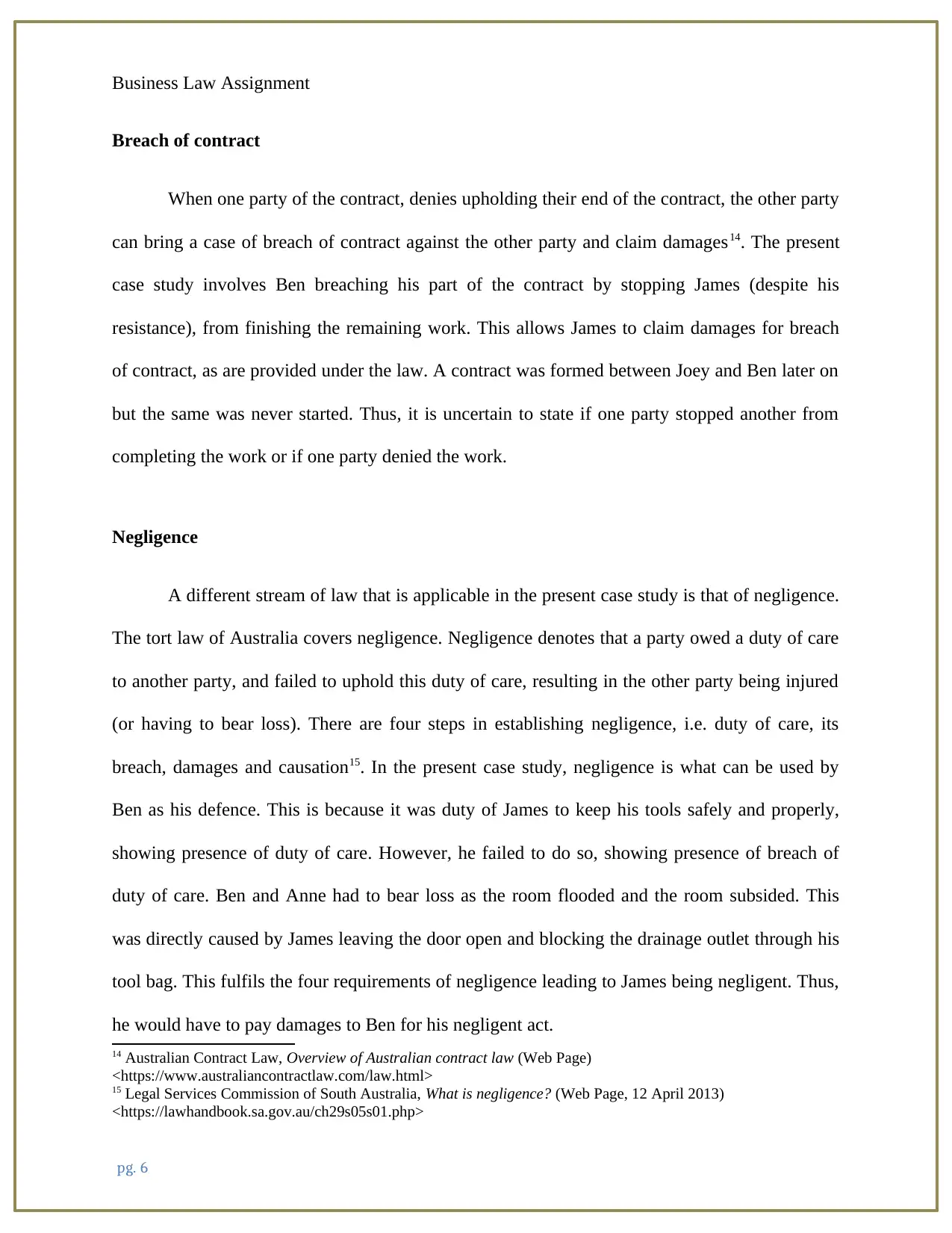
Business Law Assignment
Breach of contract
When one party of the contract, denies upholding their end of the contract, the other party
can bring a case of breach of contract against the other party and claim damages14. The present
case study involves Ben breaching his part of the contract by stopping James (despite his
resistance), from finishing the remaining work. This allows James to claim damages for breach
of contract, as are provided under the law. A contract was formed between Joey and Ben later on
but the same was never started. Thus, it is uncertain to state if one party stopped another from
completing the work or if one party denied the work.
Negligence
A different stream of law that is applicable in the present case study is that of negligence.
The tort law of Australia covers negligence. Negligence denotes that a party owed a duty of care
to another party, and failed to uphold this duty of care, resulting in the other party being injured
(or having to bear loss). There are four steps in establishing negligence, i.e. duty of care, its
breach, damages and causation15. In the present case study, negligence is what can be used by
Ben as his defence. This is because it was duty of James to keep his tools safely and properly,
showing presence of duty of care. However, he failed to do so, showing presence of breach of
duty of care. Ben and Anne had to bear loss as the room flooded and the room subsided. This
was directly caused by James leaving the door open and blocking the drainage outlet through his
tool bag. This fulfils the four requirements of negligence leading to James being negligent. Thus,
he would have to pay damages to Ben for his negligent act.
14 Australian Contract Law, Overview of Australian contract law (Web Page)
<https://www.australiancontractlaw.com/law.html>
15 Legal Services Commission of South Australia, What is negligence? (Web Page, 12 April 2013)
<https://lawhandbook.sa.gov.au/ch29s05s01.php>
pg. 6
Breach of contract
When one party of the contract, denies upholding their end of the contract, the other party
can bring a case of breach of contract against the other party and claim damages14. The present
case study involves Ben breaching his part of the contract by stopping James (despite his
resistance), from finishing the remaining work. This allows James to claim damages for breach
of contract, as are provided under the law. A contract was formed between Joey and Ben later on
but the same was never started. Thus, it is uncertain to state if one party stopped another from
completing the work or if one party denied the work.
Negligence
A different stream of law that is applicable in the present case study is that of negligence.
The tort law of Australia covers negligence. Negligence denotes that a party owed a duty of care
to another party, and failed to uphold this duty of care, resulting in the other party being injured
(or having to bear loss). There are four steps in establishing negligence, i.e. duty of care, its
breach, damages and causation15. In the present case study, negligence is what can be used by
Ben as his defence. This is because it was duty of James to keep his tools safely and properly,
showing presence of duty of care. However, he failed to do so, showing presence of breach of
duty of care. Ben and Anne had to bear loss as the room flooded and the room subsided. This
was directly caused by James leaving the door open and blocking the drainage outlet through his
tool bag. This fulfils the four requirements of negligence leading to James being negligent. Thus,
he would have to pay damages to Ben for his negligent act.
14 Australian Contract Law, Overview of Australian contract law (Web Page)
<https://www.australiancontractlaw.com/law.html>
15 Legal Services Commission of South Australia, What is negligence? (Web Page, 12 April 2013)
<https://lawhandbook.sa.gov.au/ch29s05s01.php>
pg. 6
Paraphrase This Document
Need a fresh take? Get an instant paraphrase of this document with our AI Paraphraser
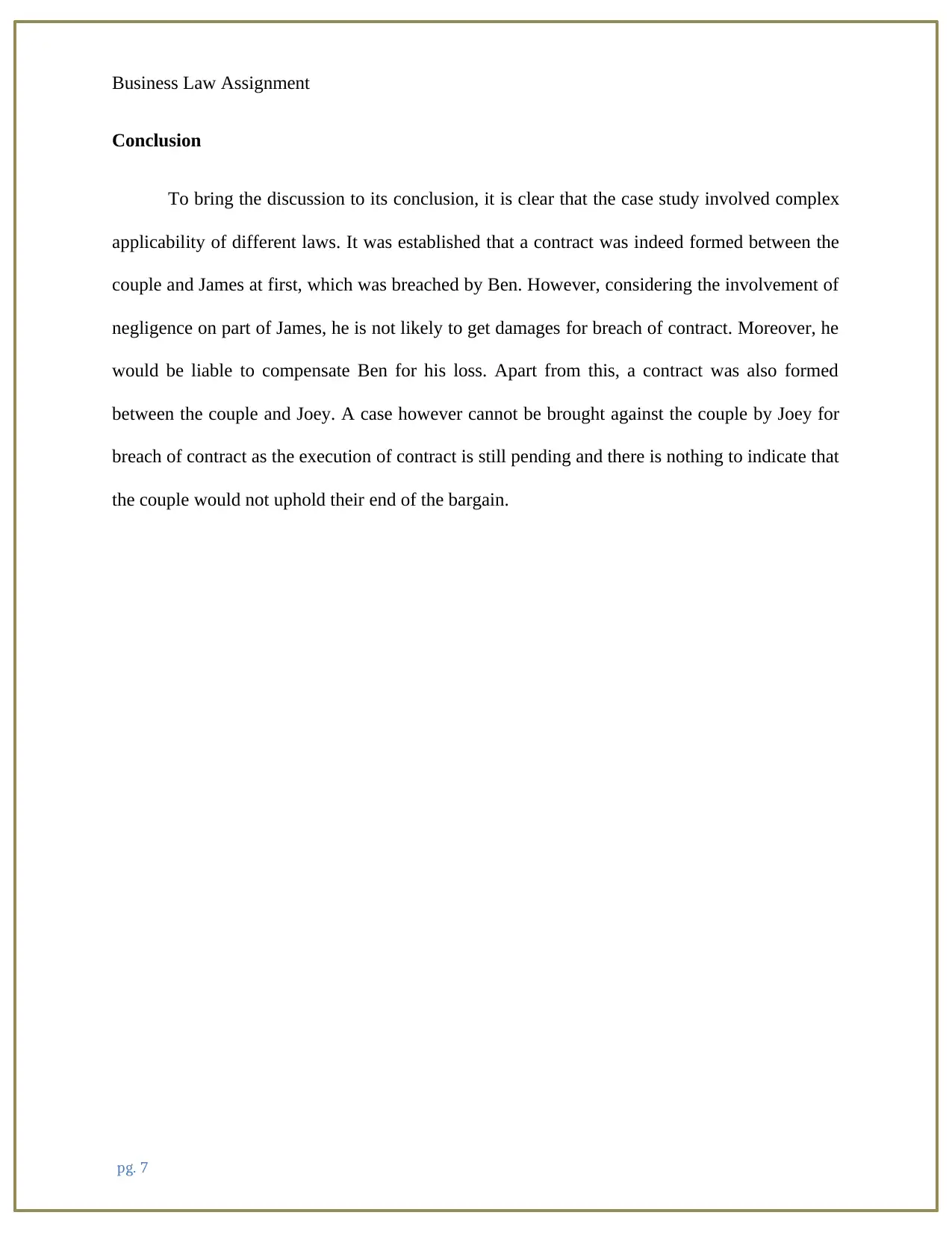
Business Law Assignment
Conclusion
To bring the discussion to its conclusion, it is clear that the case study involved complex
applicability of different laws. It was established that a contract was indeed formed between the
couple and James at first, which was breached by Ben. However, considering the involvement of
negligence on part of James, he is not likely to get damages for breach of contract. Moreover, he
would be liable to compensate Ben for his loss. Apart from this, a contract was also formed
between the couple and Joey. A case however cannot be brought against the couple by Joey for
breach of contract as the execution of contract is still pending and there is nothing to indicate that
the couple would not uphold their end of the bargain.
pg. 7
Conclusion
To bring the discussion to its conclusion, it is clear that the case study involved complex
applicability of different laws. It was established that a contract was indeed formed between the
couple and James at first, which was breached by Ben. However, considering the involvement of
negligence on part of James, he is not likely to get damages for breach of contract. Moreover, he
would be liable to compensate Ben for his loss. Apart from this, a contract was also formed
between the couple and Joey. A case however cannot be brought against the couple by Joey for
breach of contract as the execution of contract is still pending and there is nothing to indicate that
the couple would not uphold their end of the bargain.
pg. 7
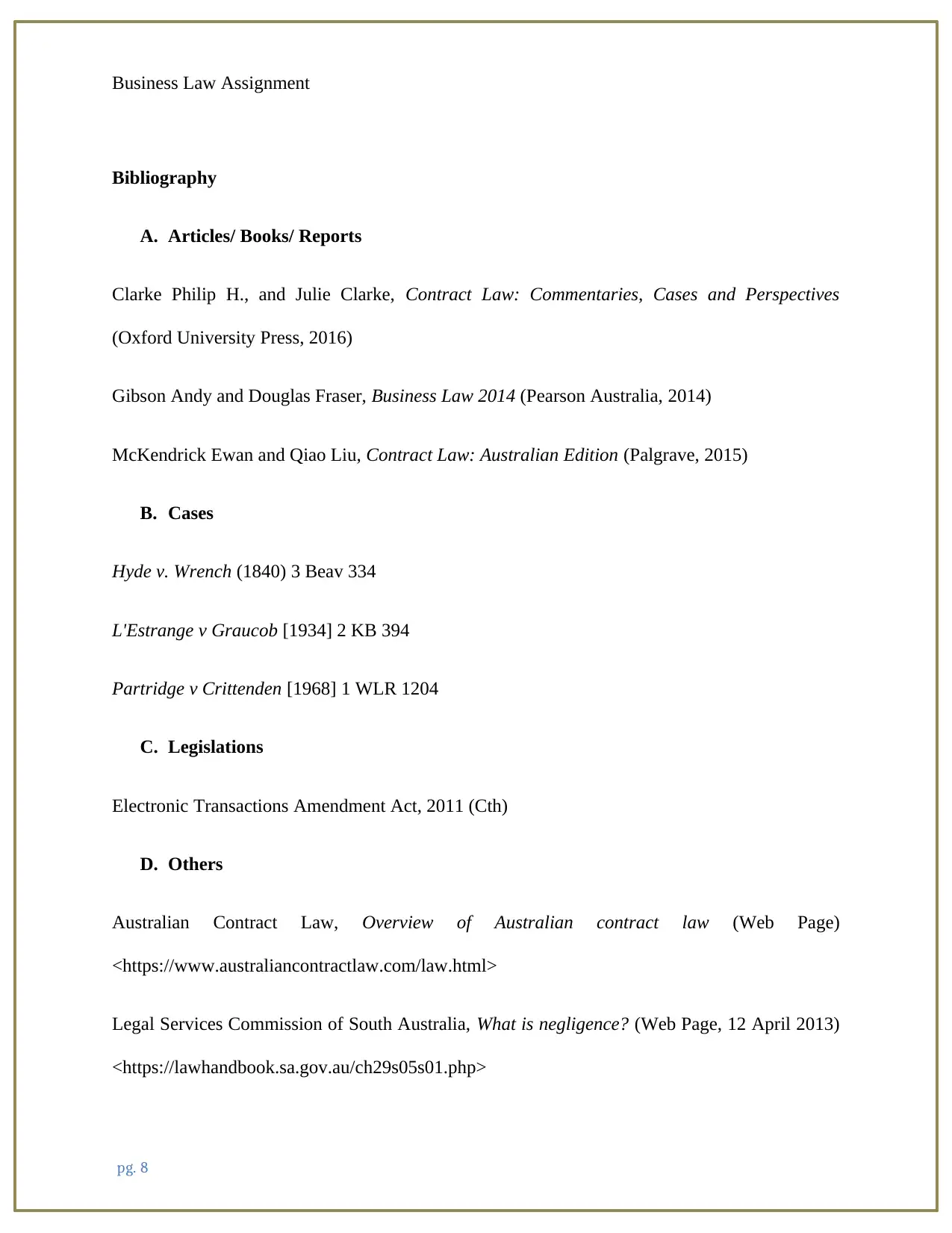
Business Law Assignment
Bibliography
A. Articles/ Books/ Reports
Clarke Philip H., and Julie Clarke, Contract Law: Commentaries, Cases and Perspectives
(Oxford University Press, 2016)
Gibson Andy and Douglas Fraser, Business Law 2014 (Pearson Australia, 2014)
McKendrick Ewan and Qiao Liu, Contract Law: Australian Edition (Palgrave, 2015)
B. Cases
Hyde v. Wrench (1840) 3 Beav 334
L'Estrange v Graucob [1934] 2 KB 394
Partridge v Crittenden [1968] 1 WLR 1204
C. Legislations
Electronic Transactions Amendment Act, 2011 (Cth)
D. Others
Australian Contract Law, Overview of Australian contract law (Web Page)
<https://www.australiancontractlaw.com/law.html>
Legal Services Commission of South Australia, What is negligence? (Web Page, 12 April 2013)
<https://lawhandbook.sa.gov.au/ch29s05s01.php>
pg. 8
Bibliography
A. Articles/ Books/ Reports
Clarke Philip H., and Julie Clarke, Contract Law: Commentaries, Cases and Perspectives
(Oxford University Press, 2016)
Gibson Andy and Douglas Fraser, Business Law 2014 (Pearson Australia, 2014)
McKendrick Ewan and Qiao Liu, Contract Law: Australian Edition (Palgrave, 2015)
B. Cases
Hyde v. Wrench (1840) 3 Beav 334
L'Estrange v Graucob [1934] 2 KB 394
Partridge v Crittenden [1968] 1 WLR 1204
C. Legislations
Electronic Transactions Amendment Act, 2011 (Cth)
D. Others
Australian Contract Law, Overview of Australian contract law (Web Page)
<https://www.australiancontractlaw.com/law.html>
Legal Services Commission of South Australia, What is negligence? (Web Page, 12 April 2013)
<https://lawhandbook.sa.gov.au/ch29s05s01.php>
pg. 8

Business Law Assignment
pg. 9
pg. 9
1 out of 10
Related Documents
Your All-in-One AI-Powered Toolkit for Academic Success.
+13062052269
info@desklib.com
Available 24*7 on WhatsApp / Email
![[object Object]](/_next/static/media/star-bottom.7253800d.svg)
Unlock your academic potential
© 2024 | Zucol Services PVT LTD | All rights reserved.




